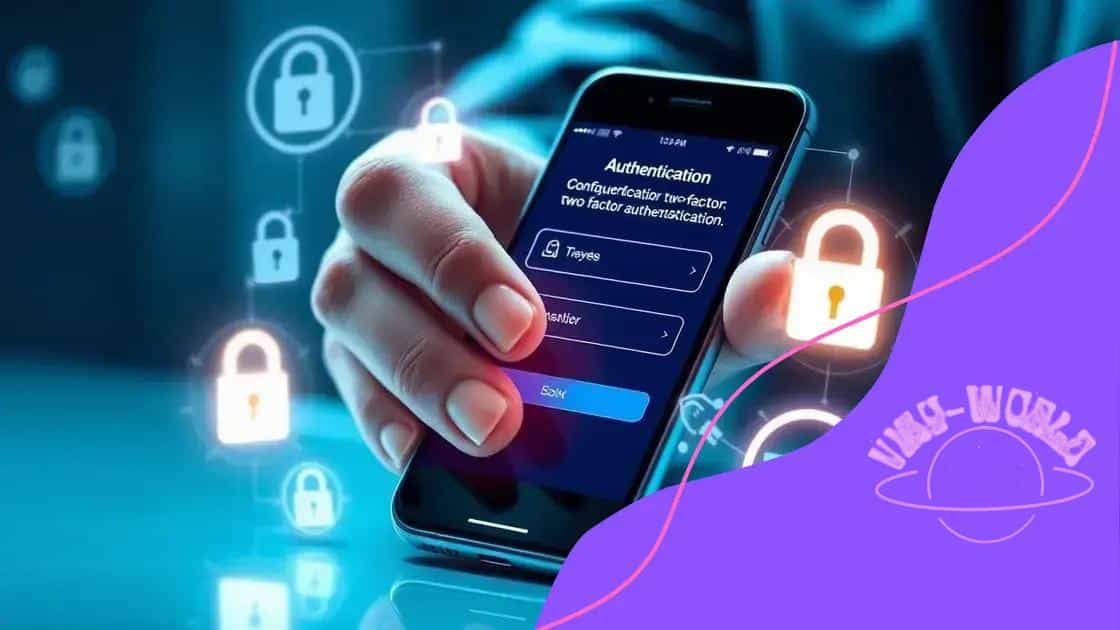Cryptocurrency security best practices: safeguarding your assets

To ensure your cryptocurrency investments are secure, implement two-factor authentication, regularly update your wallet software, and stay informed about common threats like hacking and phishing scams.
Cryptocurrency security best practices are crucial in today’s digital landscape. With more people investing in cryptocurrencies, knowing how to protect your assets can save you from potential loss. Have you ever wondered how to keep your investments safe?
Understanding common cryptocurrency threats
Understanding the digital landscape is key to protecting your investments. In the world of cryptocurrencies, various threats can compromise your safety. Common cryptocurrency threats include hacking, phishing scams, and malware. Each of these can lead to significant losses if not addressed properly.
Hacking
Hacking is one of the most prevalent risks in the cryptocurrency spaces. Hackers often target exchanges and wallets to steal funds. It’s crucial to choose a reputable exchange and enable security features, such as 2FA (two-factor authentication), to safeguard your assets. Remember that cybersecurity is always evolving, so staying informed about new threats is essential.
- Use hardware wallets when possible.
- Regularly update your software and applications.
- Monitor your accounts for suspicious activity.
Phishing Scams
Phishing is another tactic that attackers use to trick users into giving away sensitive information. These scams often come in the form of emails or fake websites. Always check URLs carefully and never click on unknown links. You should also verify any communications directly with the service provider to avoid falling victim.
This method often includes fake messages posing as legitimate requests from exchanges or wallet providers. Always verify the authenticity of any communication you receive. Be cautious and prioritize your digital safety.
Malware
Malware can infiltrate your systems and steal your private keys or sensitive data. Using unreliable software can significantly increase this risk. Make sure to install antivirus software and keep it updated to guard against potential threats. Never download files or software from untrusted sources, as this can lead to malware attacks.
By understanding these common cryptocurrency threats, you equip yourself with the knowledge necessary to protect your investments effectively. Always stay alert and prioritize security measures to keep your assets safe.
Essential wallet security measures
Securing your cryptocurrency wallet is vital for protecting your investments. There are several essential wallet security measures that every user should follow to keep their assets safe. Initially, understanding what a wallet does can help you appreciate its security needs. A wallet stores your private keys, allowing you to access your cryptocurrencies.
Choose the Right Wallet Type
There are different types of wallets: hardware, software, and paper wallets. Each has its advantages and disadvantages. Hardware wallets are the safest because they store your keys offline. Software wallets offer convenience but are more susceptible to online threats. Finally, paper wallets can be risky if not stored securely. Make a smart choice based on your needs.
- Hardware wallets are ideal for long-term storage.
- Software wallets provide easy access for trading.
- Paper wallets can be used to keep funds completely offline.
Enable Two-Factor Authentication
Two-factor authentication (2FA) adds an extra layer of security to your wallet. With 2FA, you need to enter a second code, usually sent to your phone, in addition to your password. This prevents unauthorized access even if someone learns your password. Always enable 2FA wherever it’s available for better protection.
Another security step is to create strong, unique passwords. Do not reuse passwords across different accounts, as this can increase your vulnerability. Using a password manager can help you keep track of your passwords safely.
Regular updates are also important. Ensure that your wallet software is always up to date to benefit from the latest security patches. Software updates can fix vulnerabilities and improve the overall security of your wallet. Staying proactive is critical when it comes to your finances. Protecting your wallet with these essential measures will minimize risks and help you enjoy a safer cryptocurrency experience.
Implementing two-factor authentication
 Implementing two-factor authentication (2FA) is a crucial step for securing your cryptocurrency accounts. Two-factor authentication adds an extra layer of protection, significantly reducing the risk of unauthorized access. To start, you need to enable 2FA in your wallet or exchange settings. Generally, you will do this in the security or account settings section.
Implementing two-factor authentication (2FA) is a crucial step for securing your cryptocurrency accounts. Two-factor authentication adds an extra layer of protection, significantly reducing the risk of unauthorized access. To start, you need to enable 2FA in your wallet or exchange settings. Generally, you will do this in the security or account settings section.
Choosing a 2FA Method
There are different methods for 2FA, each providing varying levels of security. The most common method is using an authentication app like Google Authenticator or Authy. These apps generate time-based codes that you enter along with your password.
- Authentication apps are more secure than SMS codes.
- SMS codes can be intercepted by hackers.
- Backup codes can be used if you lose access to your device.
Setting Up 2FA
Once you choose an authentication method, follow the instructions provided by your wallet or exchange to set it up. Usually, you will scan a QR code with your authentication app, creating a link between the app and your account. Remember to save any backup codes given during the setup process. These codes will help you regain access if you lose your device.
For maximum protection, consider regularly reviewing your security settings. Ensure that your email and account passwords are strong and unique. Additionally, keep an eye on your accounts for any suspicious activity. Having 2FA is a great start, but maintaining overall security is essential.
By implementing two-factor authentication, you greatly enhance the security of your cryptocurrency investments. This simple step can protect you from potential threats and keep your assets safer than ever.
Safe trading practices for investors
Engaging in cryptocurrency trading can be exciting, but it’s essential to follow safe trading practices to protect your investments. Start by researching the cryptocurrencies you wish to buy. Familiarize yourself with their historical performance and underlying technology. This knowledge will help you make informed decisions and avoid impulsive trades.
Use Reputable Exchanges
When trading, choose reputable exchanges with strong security measures. Look for platforms that have a good track record and positive user reviews. Using well-established exchanges lowers the risk of fraud or hacking incidents.
- Verify that the exchange has insurance against potential breaches.
- Check for user-friendly interfaces and effective support services.
- Read the latest news about the exchange to stay informed of any issues.
Implement Risk Management Strategies
Another vital practice is implementing risk management strategies. Never invest more than you can afford to lose. Many traders follow the 1% rule, meaning they only risk 1% of their total capital on a single trade. This approach helps minimize losses and protects your overall portfolio.
Make sure to utilize stop-loss orders. These automatically sell your cryptocurrency once it hits a specified price, limiting potential losses. Monitor your trades closely, but don’t let emotions drive your decisions.
Staying updated on market trends is crucial for traders. Regularly review charts and follow market news. This knowledge can inform your strategies and help you identify potential opportunities.
By following these safe trading practices, you can enhance your trading experience while minimizing risks. Remember, informed and cautious trading is the key to success in the volatile world of cryptocurrencies.
Regularly updating your security protocols
Regularly updating your security protocols is a vital component of protecting your cryptocurrency investments. Keeping your software, wallets, and exchanges current helps safeguard against vulnerabilities. Many threats arise from outdated applications that hackers can exploit. This is why timely updates are crucial.
Why Updates Matter
Updates often include security patches that address newly discovered weaknesses. By failing to install updates, you may leave your accounts open to attacks. Additionally, developers regularly enhance features and improve user experience. Staying updated ensures you benefit from the latest advancements in security technology.
- Enable automatic updates when possible.
- Regularly check for updates on your wallets and trading platforms.
- Stay informed about updates in the cryptocurrency ecosystem.
Reviewing Security Settings
While keeping software updated is essential, regularly reviewing your security settings is equally important. Check if you still have strong, unique passwords and double-check that two-factor authentication is enabled. Ensure your recovery options are up to date as well. This practice will help you remain secure against potential breaches.
Being proactive can save you from significant losses. Follow reputable security blogs and join communities where you can receive timely updates and alerts. This way, you will stay informed about any new threats or required actions.
By regularly updating your security protocols and remaining vigilant, you can better protect your investments. Adapting to the changing security landscape is essential as threats continuously evolve.
FAQ – Frequently Asked Questions about Cryptocurrency Security
What is two-factor authentication and why is it important?
Two-factor authentication (2FA) adds an extra layer of security by requiring a second form of verification, making it harder for unauthorized users to access your accounts.
How often should I update my cryptocurrency wallet software?
You should regularly update your wallet software, ideally as soon as updates are available, to ensure you have the latest security patches.
What common threats should I be aware of in cryptocurrency trading?
Common threats include hacking, phishing scams, and malware, all of which can compromise your funds and personal data.
What steps can I take to manage risk in my cryptocurrency investments?
To manage risk, only invest what you can afford to lose, diversify your investments, and set stop-loss orders to minimize potential losses.





